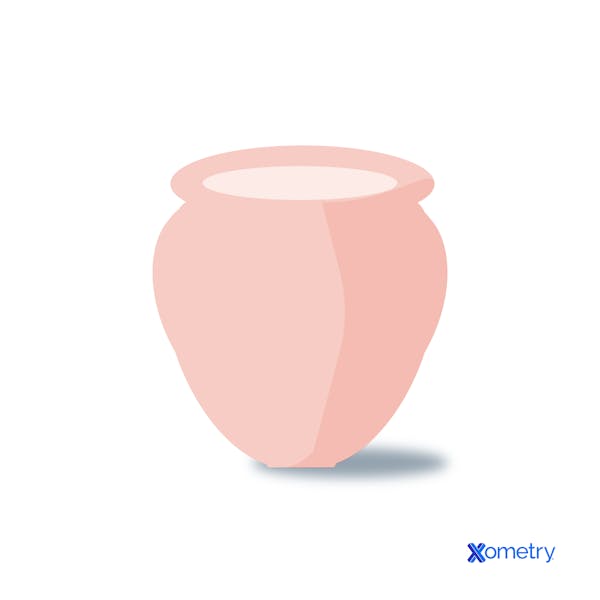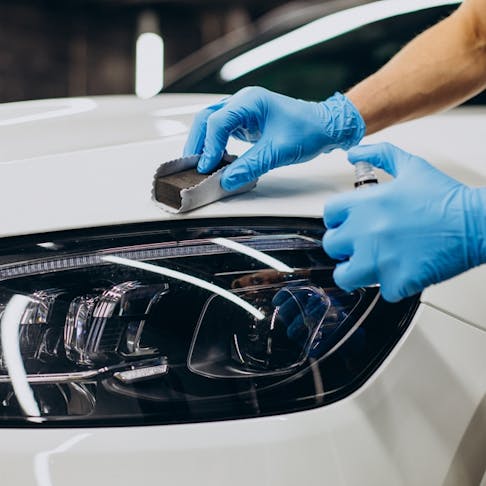Ceramic coatings are protective layers made from ceramic materials, applied to metals, plastics, composites, and glass to enhance their physical properties. Ceramic coatings are widely used as a protective layer to improve corrosion and chemical resistance, add thermal and electrical insulation, reduce friction, and increase surface hardness and wear resistance.
This article explores ceramic coatings, their working principles, applications, benefits, and drawbacks.
What Is Ceramic Coating?
Ceramic coating refers to the application of one or more ceramic compounds to a material’s surface to enhance its physical properties. These coatings provide electrical and thermal insulation, reduce friction, and improve corrosion and chemical resistance. Ceramic coatings are widely used to protect automotive exteriors, as coatings for non-stick cookware, and as insulators in various industrial applications.
What Is the Other Term for Ceramic Coating?
Other terms commonly associated with ceramic coating include nano coatings, hydrophobic coatings, silica coatings, glass coatings, and quartz coatings. While these terms are widely used in the automotive industry and are often used interchangeably in marketing, they can refer to specific formulations or properties of the coating.
What Does Ceramic Coating Do?
Ceramic coating creates a thin, protective layer of ceramic material on a substrate, enhancing its physical properties. This layer adds several properties to the product, such as electrical insulation, protection against corrosion, protection against the elements, surface hardness, and reduced friction. The variety of properties that ceramic coating can add makes it a popular process for a range of applications.
How Does Ceramic Coating Work?
In a nutshell, ceramic coating works by applying a coating compound onto a substrate, whereby the compound binds to the substrate and hardens into a thin, hard, hydrophobic layer on top of the material. The application methods can vary widely, with two common methods described below:
- Thermal Spray: Refers to several methods in which the coating compound is heated by some means, and then propelled onto the substrate at high speed, where it cools off rapidly to form the ceramic coating. Examples of thermal spray methods include the detonation gun method and plasma spraying.
- Resin: This application method is specific to ceramic coatings for cars. Here, the ceramic coating comes in a liquid form, which contains the resin and additives. In resin-based coatings, the resin polymer provides the desired physical properties, while additives enhance adhesion to the substrate. When the coating is applied onto the surface of a car, it forms a bond over the painted surface, resulting in the protective ceramic coating after it has cured.
What Is the Composition of Ceramic Coating?
Ceramic coatings are typically composed of silicon dioxide (SiO₂), though formulations may also include titanium dioxide (TiO₂), alumina (Al₂O₃), or zirconia (ZrO₂) to achieve specific properties. For industrial ceramic coating applications, these coatings usually come in powdered form. The powder is heated until soft and propelled at high speeds onto a material, where it rapidly cools and bonds to the material to form a hard protective layer.
For ceramic coatings used on cars, the coating may come in liquid form. In these types of coatings, the liquid coating contains the ceramic coating resin itself, as well as additives that improve the adhesion of the coating to a car’s surface.
Does Ceramic Coating Contain PTFE?
No, ceramic coatings do not contain PTFE. PTFE, also known as polytetrafluoroethylene, is a hydrophobic composition used to reduce friction on materials. It is commonly used as a non-stick coating for cookware or as a lubricant in manufacturing or components. While there are many formulations of ceramic coatings, they do not contain PTFE. Instead, they rely on ceramic compounds to achieve friction reduction and other enhanced surface properties.
Where Is Ceramic Coating Used?
Ceramic coatings are applied across various industries to impart enhanced properties—such as corrosion resistance, thermal insulation, and reduced friction—to components. One of the most common applications is automotive ceramic coating, where a liquid coating is applied to a car’s exterior and cured into a hard, protective layer that shields the paint, reduces dirt adhesion, and offers a cost-effective method of protection.
Ceramic coating is also used in non-stick cookware, offering an alternative to compounds such as Teflon®. In this case, the coating is used to prevent food from sticking to cookware. Other uses of ceramic coating include: as a means of corrosion protection for pipelines and equipment, to reduce friction between mechanical components, and to add electrical insulation to components in electrical, industrial, and automotive applications.

How Is Ceramic Coating Used in Manufacturing Industries?
Ceramic coating offers many desirable properties that are useful in manufacturing. One of the main ways ceramic coatings are used is to reduce friction between mechanical parts. This reduces wear, increasing the life span of components, as well as reducing maintenance requirements.
Other ways that ceramic coatings are used include adding corrosion and chemical resistance, as well as thermal insulation. These also increase the longevity of components and are especially useful for harsh applications.
What Effect Does Ceramic Coating Have When Applied to Aluminum Alloys?
Ceramic coating improves the surface hardness and wear resistance of aluminum alloys. Aluminum alloys can be prone to surface wear due to the softness of their surface. This can lessen the life span of aluminum alloys, making them unsuitable or undesirable for certain applications. By applying a ceramic coating to aluminum alloys, their surface hardness is increased, improving wear resistance and increasing their life span.
To learn more, see our Aluminum Alloy guide.
Can Ceramic Coating Be Used on Kitchenware?
Yes, ceramic coating is commonly used on non-stick kitchenware. Ceramic coatings add lubricity to cookware, preventing food from sticking to it. Additionally, ceramic coatings are non-toxic, especially compared to traditional non-stick compounds such as PTFE.
How To Apply Ceramic Coating?
Ceramic coatings can be applied in several ways, depending on the application. The following list summarizes some of the application methods:
- Ceramic Coating a Car: Liquid ceramic coatings for cars are applied to a thoroughly cleaned and detailed painted surface using straight-line motions. After application, the excess coating is wiped off gently, and the car must cure for at least two days before exposure to water.
- Plasma Spraying: In plasma spraying, a plasma flame heats coating particles to very high temperatures. These particles are then propelled onto a substrate, where rapid cooling forms a durable ceramic coating.
- Detonation Gun (D-Gun): The D-Gun method is a popular thermal spray process where a mixture of oxygen and fuel detonates to heat and spray powder onto a substrate. An inert gas is then pulsed through the sprayer to purge it, and this cycle is repeated rapidly to form a strong, dense coating.
- Chemical Vapor Deposition (CVD): CVD applies ceramic coatings by introducing reactive gases that chemically react with the substrate, forming a thin, uniform film over the surface.
How Long Does Ceramic Coating Last?
Ceramic coatings generally last for years, though their exact lifespan depends on the application and maintenance. On cars, ceramic coatings typically last two to five years, with factors like harsh chemicals, extreme weather, and improper maintenance reducing durability. Ceramic-coated cookware may last one to three years, while industrial coatings, exposed to chemicals, high temperatures, or mechanical impacts, also typically last several years.
What To Do To Maintain Ceramic Coating?
To maintain a ceramic coating, care should be taken to do the following:
- Avoid using harsh chemicals on the ceramic coating, as this can deteriorate the coating.
- Avoid using sharp implements or abrasives on the coating, as this can lead to scratches.
- Avoid polishing or other abrasive methods of cleaning, as this can scratch and deteriorate the coating.
- For a ceramic coating on a car, surface debris should be cleaned off every few weeks.
- Ceramic-coated cookware should be washed with warm, mild soapy water after each use.
Is Ceramic Coating High Maintenance?
No, ceramic coating is generally low maintenance, but proper care is essential. Using harsh chemicals, high-speed polishers, or abrasive tools can wear or scratch the coating, leading to deterioration.
What To Avoid After Ceramic Coating?
After applying a ceramic coating on a car, allow the coating to cure for at least two days before exposing it to water; full curing may take several days. Avoid washing the car for up to two weeks, and minimize exposure to water and rain. Promptly remove contaminants such as tree sap, bird droppings, or bug splatter.
How Much Does Ceramic Coating Cost?
The cost of ceramic coatings depends on factors such as the application, type of coating, method of application, size of the product, and geographical location. Professional automotive ceramic coating can cost up to $5,000, while DIY applications may cost under $100, depending on the supplies and materials used.
For industrial ceramic coatings, the costs can vary significantly depending on the method of application, the product to be coated, and the composition of the coating.
Is Ceramic Coating Expensive?
Industrial ceramic coatings can be expensive due to the complexity of proper application and the cost of coating compounds. However, their unique benefits, such as enhanced durability and performance, can make them cost-effective compared to the expense of replacing components.
What Are the Benefits of Ceramic Coating?
Ceramic coatings provide several benefits, such as:
- Increased surface hardness, which reduces wear and extends component longevity.
- Reduced friction, beneficial for non-stick cookware and for minimizing wear on mechanical parts.
- Thermal insulation, protecting components in high-temperature applications.
- Electrical insulation, safeguarding tools and equipment in the electrical, automotive, and industrial sectors.
- Enhanced corrosion and chemical resistance, offering broad protection across various industries.
What Are the Downsides of Ceramic Coating?
Ceramic coating does have a few downsides:
- It is fairly complex to apply correctly and requires professional application for the most part.
- Ceramic coatings form a semi-permanent bond with the substrate, making removal nearly irreversible except by abrasive methods that may damage the underlying material.
- Tends to be fairly expensive due to the complexity and composition of the coating.
Is It Okay To Wax Over Ceramic Coating?
Yes, waxing over a ceramic coating on a car is acceptable and can enhance the finish. However, the coating should not be polished, as traditional polishing methods can deteriorate it.
Is It a Good Idea To Pressure Wash a Ceramic-Coated Car?
Yes, a ceramic-coated car can be pressure washed without any concerns for damaging the ceramic coating, as long as the coating has been fully cured. The curing process may take up to two weeks, during which the car should not be washed to ensure proper bonding of the coating.
What Is the Difference Between Ceramic Coating and Teflon Coating?
Ceramic coating is a coating that consists of a ceramic compound such as SiO2 or TiO2. Teflon® coating is a PTFE coating that is commonly applied to non-stick cookware. Both ceramic coatings and Teflon® coatings are used to impart non-stick properties to cookware; however, Teflon® coatings are generally engineered for longer-lasting performance and may offer superior food release, though results can vary by formulation. However, Teflon® consists of PTFE, which can potentially release harmful fumes. Ceramic coatings are non-toxic and are generally marketed as the safer option despite being more expensive and not lasting as long.
Summary
This article presented ceramic coating, explained it, and discussed how it works and its benefits. To learn more about ceramic coating, contact a Xometry representative.
Xometry provides a wide range of manufacturing capabilities, including machining and other value-added services for all of your prototyping and production needs. Visit our website to learn more or to request a free, no-obligation quote.
Copyright and Trademark Notice
- Teflon® is a registered trademark owned by Chemours (formally DuPont)
Disclaimer
The content appearing on this webpage is for informational purposes only. Xometry makes no representation or warranty of any kind, be it expressed or implied, as to the accuracy, completeness, or validity of the information. Any performance parameters, geometric tolerances, specific design features, quality and types of materials, or processes should not be inferred to represent what will be delivered by third-party suppliers or manufacturers through Xometry’s network. Buyers seeking quotes for parts are responsible for defining the specific requirements for those parts. Please refer to our terms and conditions for more information.


